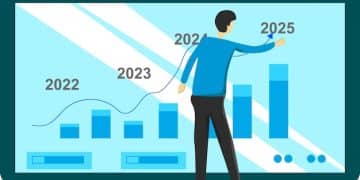Track Your Expenses Effectively in 2025: A Comprehensive Guide

Tracking your expenses effectively in 2025 involves leveraging modern tools, adopting strategic budgeting techniques, and regularly reviewing your financial habits to achieve financial clarity and control.
Want to get a handle on your finances? Learning how to track your expenses effectively in 2025 is your first step toward financial freedom. This guide will walk you through the best strategies and tools for success.
Why Tracking Your Expenses is Crucial
Tracking your expenses might seem tedious, but it’s a powerful tool. Understanding where your money goes is the foundation for making informed financial decisions. Let’s explore why this practice is so important.
Gaining Financial Awareness
Expense tracking illuminates your spending habits. When you know exactly how much you’re spending on coffee, subscriptions, or entertainment, you can identify areas where you might be overspending.
Budgeting More Effectively
A solid budget relies on accurate expense data. By tracking your spending, you can create a realistic budget that aligns with your actual income and expenses. This allows you to allocate funds more strategically.
Achieving Financial Goals
Whether you’re saving for a down payment on a house, paying off debt, or planning for retirement, knowing where your money goes is the first step. Expense tracking helps you stay on track and make progress toward your financial goals.
- Identifies areas for potential savings.
- Provides a clear picture of your financial health.
- Enables informed decision-making about spending.
- Promotes financial discipline and responsibility.
Ultimately, tracking your expenses gives you control over your finances. It’s not just about cutting back; it’s about making choices that align with your values and help you achieve your long-term financial objectives. By understanding your spending patterns, you can confidently navigate your financial future.
Choosing the Right Expense Tracking Method
There’s no one-size-fits-all approach to expense tracking. The best method depends on your preferences, lifestyle, and financial goals. Here’s a look at some popular options, each with its own set of advantages and disadvantages.
Budgeting Apps
Budgeting apps have become increasingly sophisticated and user-friendly. Mint, YNAB (You Need a Budget), and Personal Capital are popular choices. These apps automatically track your transactions, categorize expenses, and provide insights into your spending habits.
Spreadsheets
If you prefer a more hands-on approach, spreadsheets offer flexibility and customization. You can create your own expense tracking template using Microsoft Excel or Google Sheets. This allows you to tailor the categories and reporting to your specific needs.
Manual Tracking
For those who prefer a minimalist approach, manual tracking with a notebook or paper ledger can be effective. While it requires more effort, it can also be more mindful. Jotting down each expense as it occurs can create greater awareness of your spending habits.

- Budgeting Apps: Automated tracking, insightful reports, and user-friendly interfaces.
- Spreadsheets: Highly customizable, offers complete control over data, and requires manual input.
- Manual Tracking: Simple, mindful, and requires consistent effort to record every expense.
Choosing the right method involves considering your comfort level with technology, your willingness to dedicate time to tracking, and the level of detail you desire. Experiment with different approaches until you find one that fits seamlessly into your daily routine.
Setting Up Your Expense Tracking System
Once you’ve chosen your method, it’s time to set up your expense tracking system. This involves defining your expense categories, linking your accounts (if using an app), and establishing a routine for recording your expenses.
Defining Expense Categories
Start by creating a list of expense categories that reflect your lifestyle and spending habits. Common categories include housing, transportation, food, entertainment, and utilities. Be as specific as possible to gain detailed insights.
Linking Accounts and Automating Tracking
If you’re using a budgeting app, link your bank accounts, credit cards, and investment accounts. This allows the app to automatically import transactions and categorize them based on predefined rules. Automation saves time and reduces the risk of human error.
Establishing a Routine
Consistency is key to successful expense tracking. Set aside a specific time each day or week to review your transactions and categorize any uncategorized expenses. The more consistent you are, the more accurate your data will be.
Setting up your expense tracking system is a personal process. Tailor your categories and routines to align with your specific needs and goals. The goal is to create a system that is both effective and sustainable in the long run. Once your system is in place, you can start gathering valuable data about your spending habits.
Analyzing Your Spending Patterns
With your expense tracking system in place, you can begin analyzing your spending patterns. This involves reviewing your expense data, identifying trends, and uncovering areas where you can potentially save money.
Reviewing Expense Data
Regularly review your expense data to identify where your money is going. Look for patterns and trends that might not be immediately obvious. Are you spending more on dining out than you realized? Are your subscription costs adding up?
Identifying Trends
Over time, you’ll start to notice trends in your spending habits. These trends can provide valuable insights into your financial priorities and areas where you may want to make changes. For example, you might discover that you spend a significant amount on impulse purchases or convenience items.
Uncovering Savings Opportunities
By analyzing your spending patterns, you can uncover opportunities to save money. Perhaps you can reduce your dining out expenses by cooking more meals at home, or cancel unused subscriptions to free up cash flow.

- Reviewing Data: Examining categorized expenses to identify spending patterns.
- Identifying Trends: Spotting recurring habits and tendencies in your financial behavior.
- Uncovering Savings: Finding areas where you can cut back spending and save more money.
Analyzing your spending patterns is an ongoing process. Regularly revisiting your data will help you stay on track, adjust your budget as needed, and make progress toward your financial goals. Remember, the goal is not just to cut back, but to align your spending with your values and priorities.
Setting Financial Goals and Aligning Expenses
Tracking your expenses is most effective when combined with clear financial goals. Whether you’re saving for a specific purchase, paying off debt, or building long-term wealth, aligning your expenses with your goals is crucial for success.
Defining Your Financial Goals
Start by defining your financial goals. What do you want to achieve in the short, medium, and long term? Do you want to buy a house, start a business, or retire early? Be specific and set measurable targets.
Prioritizing Your Spending
Once you know your goals, prioritize your spending accordingly. Allocate more funds to the categories that support your goals, and cut back on expenses that don’t align with your priorities. This requires making conscious choices about where your money goes.
Adjusting Your Budget
Regularly review your budget and adjust it based on your progress toward your goals. If you’re falling behind, identify areas where you can reduce spending or increase income. Flexibility is key to staying on track.
Setting financial goals and aligning your expenses is a continuous process. As your goals evolve and your circumstances change, be prepared to adapt your budget and spending habits accordingly. By staying focused on your goals and making informed choices, you can achieve financial success.
Tools and Apps to Enhance Expense Tracking in 2025
The landscape of expense tracking tools and apps is constantly evolving. In 2025, expect to see even more sophisticated features, artificial intelligence integration, and personalization options.
AI-Powered Budgeting
AI is already playing a role in budgeting apps, but expect to see greater integration in 2025. AI can analyze your spending patterns, provide personalized recommendations, and even automate certain tasks, such as categorizing expenses and negotiating bills.
Improved Automation
Automation will become even more seamless and intuitive. Apps will be able to automatically detect recurring expenses, identify potential savings opportunities, and even transfer funds to savings accounts based on predefined rules.
Enhanced Personalization
Expense tracking tools will offer greater personalization options. You’ll be able to customize your categories, reports, and insights to align with your specific needs and goals. This will make the experience more relevant and engaging.
In 2025, the tools and apps available for expense tracking will be more powerful, user-friendly, and personalized than ever before. By leveraging these advancements, you can gain even greater control over your finances and achieve your financial goals more efficiently.
| Key Point | Brief Description |
|---|---|
| 📊 Track Expenses | Monitor your spending to gain financial insights. |
| 🎯 Set Goals | Define clear financial objectives for focused budgeting. |
| 🤖 Use Apps | Automate tracking with budgeting apps for efficiency. |
| 🔄 Review & Adjust | Regularly analyze and adapt your budget for success. |
Frequently Asked Questions
▼
Tracking your expenses helps you understand where your money is going, enabling you to make informed financial decisions and identify areas for potential savings.
▼
Effective methods include using budgeting apps, spreadsheets, or manual tracking with a notebook. Choose the method that best fits your lifestyle and preferences.
▼
It’s recommended to review your expenses at least once a week to stay on top of your spending habits and identify any unusual transactions.
▼
Common categories include housing, transportation, food, entertainment, utilities, and debt payments. Tailor your categories to match your specific spending patterns.
▼
By tracking your expenses, you can identify areas where you can cut back and allocate more funds towards your financial goals, such as saving for retirement or paying off debt.
Conclusion
Mastering how to track your expenses effectively in 2025 involves embracing technology, setting clear financial goals, and consistently monitoring your spending habits. By implementing these strategies, you’ll pave the way for a brighter, more secure financial future.





